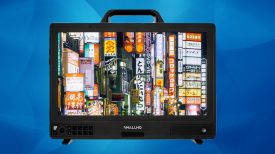By Jonah Kessel:
Seven shooters from seven different countries were recently flown to Italy to create short videos, which would be combined to create a digital diary of the Friuli–Venezia Giulia region of Northern Italy. As one of the seven, I knew this was going to be a very tough assignment (please use sarcastic inner monologue while reading this sentence): a week of being force fed prosciutto by the truck-load, drowned in wine and guided through the region. Our itinerary was impressively long – taking in everything from caving to wine tasting and from tours of iconic monuments to boating — with every day packed from sun up to sun down.
By putting me in almost every imaginable scenario – light, dark, dry, wet, very wet, fast, slow, tricky, easy, complicated – the assignment would be a great opportunity to test my new Canon 5D mkIII.

I’d read dozens of reviews, both good and many more on the negative side, but while many seemed to be reviewing the camera from their desks, studios and computers, this would be a genuine field test – 300 gigabytes of it. Visiting one thousand different, unrelated places didn’t necessarily make for the best story-telling scenario, but it did give me an opportunity to understand the camera. And after reading so many reviews from pixel pushers taking the “disappointed” view, this is my take; not talking about specs and “what’s under the hood” but simply as someone whose best friend for the past two years has been the Canon 5D mkII.

First things first — this is perhaps the most common statement we read in reviews about the 5D mkIII:
“It is an evolutionary upgrade rather than a revolutionary one.” (source one, source two, source three, source four)
I agree that the 5D Mark II’s video capabilities were “revolutionary”. It was the first DSLR that shot HD video (ed – if you don’t count the Nikon D90).
But what would make the 5D mkIII “revolutionary”? We knew it wouldn’t do our taxes or walk our dogs. Pixel pushers might think it revolutionary if it had 36 megapixels, but I have a feeling most wouldn’t.

Would it be a revolution if it shot 60 fps at 1080p? That probably wouldn’t cut it either.
But if we stop and look at the camera we might think a bit differently. It’s a revolution in this camera model’s life cycle. It takes what the already amazing 5D mkII does — and does it better. All of the systems in the Mark III have been upgraded. Sure, the camera has the same surname as its predecessors — but for all intents and purposes, it’s a completely new and different camera. It feels different. It operates differently.
For me the differences in the 5D Mark II and Mark III were very obvious. And despite what some very scientific tests are saying, the most obvious change I noticed was in the picture itself — specifically in the dynamic range of colors the camera was recording, both in good and bad lighting situations.

I noticed the difference in the low and mid ranges a little more than the highs, seeing detail and color in places where I believe the Mark II would have dropped blacks below to zero percent. I noticed this most when there was high contrast lighting; times when light within a single frame varied from very bright to very dark. On a very sunny day, where my exposure was set to properly expose the highs, I was seeing way more detail in the lows (vertical pan, 47 seconds in). It looked like I had shot flat with Technicolor’s CineStyle gamma and LUT, without the hassle of actually doing it.
I also found an enormously visible difference in low light performance. I was able to shoot in caves with no natural light at ISOs as low as 640 (1:07 in) and nearly black wine cellars at ISO 3200 (40 seconds in). While there is some grain, it is fairly minimal. Thinking back to shooting at standard intervals of ISO 160 on the 5D Mark II, I know exactly how it would have performed in these environments. On the 5D mkIII there were natural colors in my frames, where R, G and B values remained relatively even, showed much less grain and more variation in color.
As a working documentarian and visual journalist, I’m constantly put into poor lighting situations. I’m also often in rushed or sensitive situations where I don’t have lights with me. The camera’s improved low light performance alone is worth it for people who find themselves shooting in less than ideal lighting situations.

Another advantage I noticed came in its LCD screen. At the moment I’m favoring a Blackbird stabilization device over the various shoulder rigs I’ve been using the past year, although it isn’t as practical to use in some situations. I own both on camera viewfinders and small HDMI monitors but now I’m noticing I don’t feel like I need them 90% of the time. I know they make things easier to see, but I don’t notice my videos coming out differently. More often than not, I feel it’s there to assure a client the camera is “more than a DSLR.”
Nonetheless, here’s where the Mark III’s LCD comes in. It’s only .2 inches bigger, with an additional 120,000 dots, but that difference to me is enormous. I feel like I’ve upgraded from a 19″ square TV to a 43″ plasma.
The entire video above was shot without additional viewfinders or monitors. This isn’t to say I don’t think viewfinders and monitors are useful, but the additional clarity and size of the new LCD certainly helps. When using a device like a Blackbird (any of the side car footage, vineyard sweep at 37 seconds), then the less weight, the easier the device is to work with.
Of course, another explanation is simply — I’m not happy with my view finder systems now and the Mark III offers a little bit of breathing room.
A lot of Mark III users have commented on sharpness, pointing out that the footage requires sharpening in post. Some shots in this video, I touched with a sharpening filter — but it was very minimal. The majority of the footage is actually fairly similar to the out of camera footage. Every frame has been hit with 3-way color filter, but you are not seeing too much post production.
Last week, Dan’s post comparing the Mark III to the EOS-1D X showed some interesting results. I’ve watched this video full screen a couple times and do see a difference; however, I think it’s fairly minimal. I think the compressed versions probably hurt a test like this, but the 1D X’s footage does appear slightly sharper.

After I finished shooting the tourism-related video in Friulu, I had the chance to go to Venice to try out the camera’s new still capabilities. Although I predominantly use my DSLRs as video cameras, I also take assignments for still photography. Spending two days in Venice shooting stills with the 5D mkIII was a real treat.
In this area, the camera seemed to be miles ahead of its predecessor. And in many ways — it was simply refreshing, although a bit difficult to get my finger memory to change up from the 5D Mark II.
Once I got some rhythm down, operation became quick and easy. Now that I’m used to it, the Mark III’s focusing system really feels like driving a luxury car.

To say the least, the customization options within the AF system are very impressive. I also explored the new HDR function of the camera. I’ve been very skeptical watching the HDR world grow over the past couple years — and if you asked me a couple months ago, I probably would have said I don’t like it. Slowly I’ve come around to it more, depending on its usage. But now, the in-camera HDR makes the form factor much more applicable.
Looking further into the possibilities of HDR time-lapse photography, the functionality could really become something amazing. You might call it — revolutionary.

There are certainly missing features I would have liked to see on the 5D mkIII, including 60 fps at 1080p. However, the benefits of the camera far outweigh the things I didn’t have anyway, and I can’t say I’m really missing a 36 MP sensor. For what I do, I don’t really need a 4K DSLR and shooting super slow motion doesn’t seem to be an option in the DSLR world (yet). And sure, it cost more than the 5D Mark II – but hey, it’s a better camera.
So to all you pixel pushers, naysayers and whiners — I say: Bugger off. The camera is a big upgrade.
— Jonah M. Kessel is a Beijing based freelance visual journalist working with the New York Times. See his web site here, follow him on Twitter here or keep up with his seemingly strange travel schedule and antics at his blog here.






